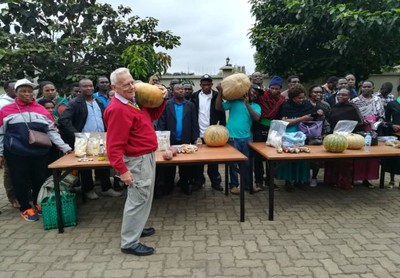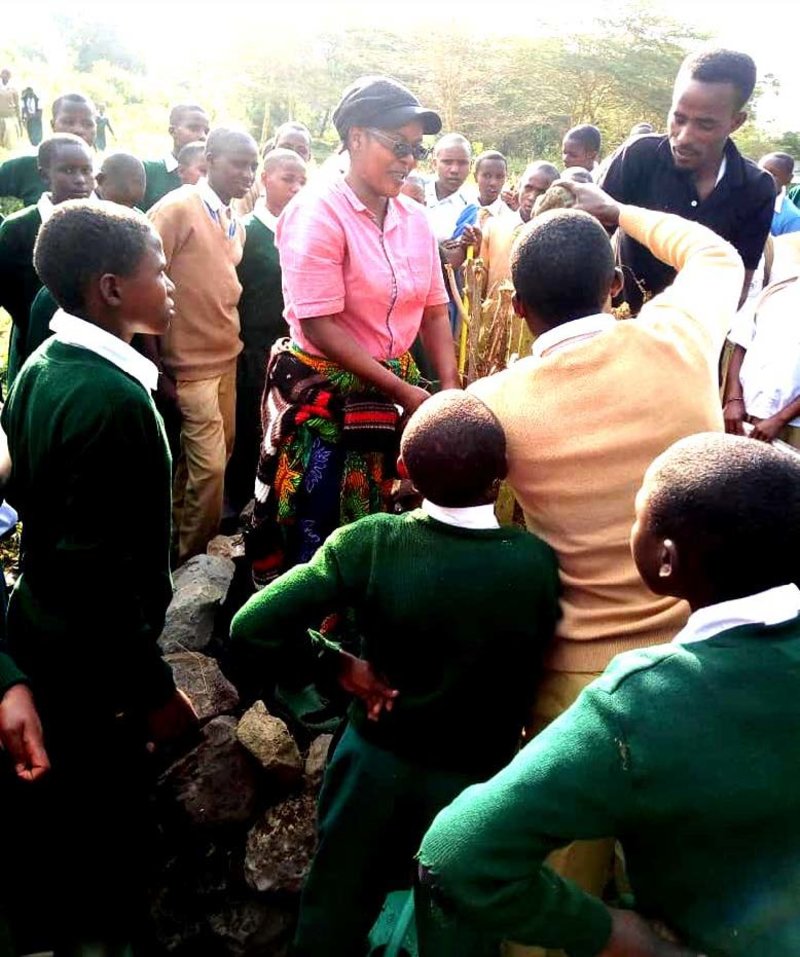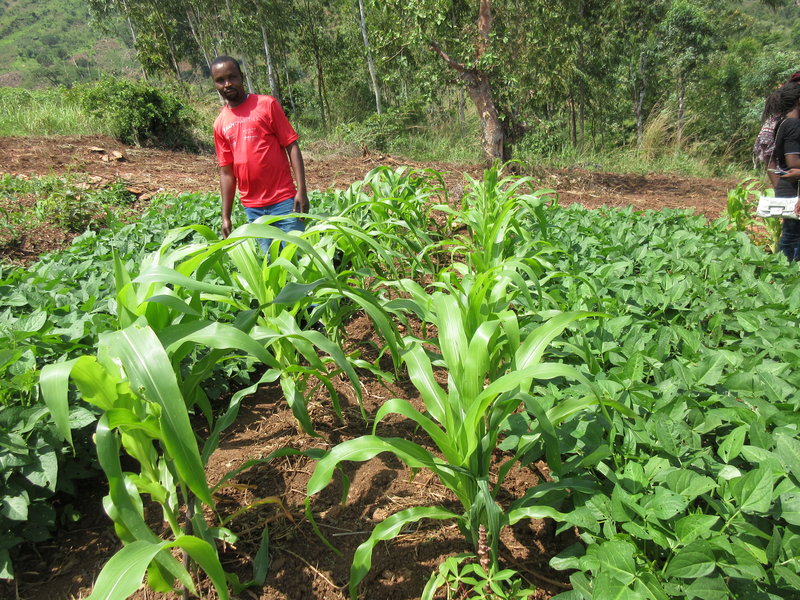ECHOcommunity Updates
EDN Issue 141 - Now Available 2018-10-17
In this issue:
- Shea Nut: The Butter Tree
- For How Long Should Chaya Leaves be Boiled?
- Green Leafy Vegetables: Leaf Powder for Improved Nutrition
- From ECHO's Seed Bank: Jewels of Opar, An edible ornamental
- SPRING Nutrition-Sensitive Agriculture Training Resource Package
Shea Nut: The Butter Tree
By: Gene Fifer
Excerpt:
The arid region directly south of the Sahara Desert (the Sahel), which stretches from Senegal to Ethiopia, has limited sources of fats and oils. Dairy products from cows and sheep are scarce and traditional oilseed crops are few. This is problematic for human health since fats and oils contain lipids essential for vitamin absorption and are a high-calorie energy source.
The shea nut tree (Vitellaria paradoxa) is a widely distributed and traditional source of vegetable fat in the Sahel for the Bambara, Dyula, Fulani, Hausa, and Wolof peoples. Some of its common names suggest its dietary importance: bambouk butter tree, galam butter tree, and arbre à beurre. Other common names in many different languages include karité, cárei, carité, lulu, sirreh, se, berekunan, tamba, taanga, and kareje. Fruity pulp and butter from shea nut trees are important food sources during the ‘hunger months’ of the early rainy season, before annual crops are harvested. However, even though the shea nut tree is widespread and traditionally used, it is underutilized because of the high amounts of labor, fuel, and water that are required to process it. The grueling and resource-intensive butter-making process can be streamlined by modern, low-tech methods that could expand its use as a hedge against food insecurity.
Revalorizing Ancestral Mayan Crops 2018-10-12
There is currently a movement among scientists, nutritionists, development workers, and agriculturalists to recognize, revalorize, and promote the treasures of Guatemalan food culture for the health and well-being of the most vulnerable. In March 2018, I had the privilege to attend events held to this end including a conference titled, “Chaya in Guatemala: Participatory Consultation on Needs, Challenges, and Opportunities,” and a Chaya Processing Workshop hosted by Bioversity International and Universidad del Valle de Guatemala (UVG, Del Valle University of Guatemala); and also a meeting titled “Revalorizing Native Plants with High Nutrient Value to Promote Food Security and Commercialization,” hosted by Asociación Gremial Empresarial Rural (AGER, Association of Rural Entrepreneurs) and Red de Alimentos Ancestrales Nutricionalmente Mejorados (Red Wa, Network of Nutritionally Improved Ancestral Foods).
The Value of a Seed: Growing a Network of Community Level Seed Banks in Asia 2018-09-20
As an organization that seeks to equip people with agricultural resources and skills, we often find ourselves coming back to the seed. Again and again we witness the value of saving open-pollinated seeds, shedding light on locally adapted and underutilized plants of merit, and researching innovative low-cost seed storage technologies. These activities form the foundation of ECHO’s ability to empower others in their endeavors to improve food and agricultural systems around the world.
Building on a longstanding history of seed bank operations, first in Florida, and now Asia and Africa, ECHO continues to expand its capacity for placing seeds into the hands of those in need. In 2009, with the establishment of Asia’s Regional Impact Center and Seed Bank, the first step was taken in an ongoing process to house seeds of regional merit and local importance on location. To date, ECHO’s first regional seedbank is striving to meet a growing demand for locally-adapted, open-pollinated seed from within our network, and its success attests to the wisdom of its establishment. Distributing over 4,600 trial seed packets in 2017, from a selection of 175 different varieties, the Asia Seed Bank serviced network partners in 29 countries, with seeds grown and produced right here in SE Asia!
In light of these achievements however, demand for more seeds has stretched our capacity to fulfill the needs of a massive Asian audience, thus requiring our own explorations for further growth. This, combined with a growing challenge of moving seeds across borders, tightening seeds laws, and continued debates over ownership of genetic materials, has forced us into thinking very intentionally to the future of our seed banking activities. These questions have pushed us to consider how we might continue to serve our network in this critical realm.
Seed Exchange From Mbeya to Arusha, A Story of James and Jennifer Kahurananga 2018-09-05
Guest Post from ECHO East Africa
By Malvery Begley, US Peace Corps volunteer
Arusha Conservation Agriculture Forum (ACAF) was formed after the first Farming God's Way training, when participants wanted to support conservation agriculture. Chrispin Mirambo was the first secretary and since the beginning of ECHO, ECHO has taken on a main role to host and be ACAF’s current secretariat. ACAF members are comprised of various NGOs and governmental organizations within the Arusha area; TPRI, MWIVATA, Horticulture Tengeru, local farmers, journalists and teachers make up the majority of members. These stakeholders meet after every three months to discuss current issues in conservation agriculture and other work that is being implemented. The ACAF members have benefited from learning various techniques and better practices from surrounding organizations and institutes in the Arusha region of Tanzania. In 2014 ACAF created a seed exchange initiative where local farmers can exchange indigenous seed varieties with other farmers. Since ACAF has been established, the seed exchange has been held three times. Members of ACAF and participants of the seed exchange program have encouraged ECHO to continue and increase the program because of its huge benefits to farmers.
PITA Project Has Opened Our Eyes 2018-08-13
In Meru district where this project is offered, farmers grow bananas and coffee in the highlands, and maize and beans in the lowlands. Many are also involved in small commercial horticulture. They mainly depend on surplus for cash but primarily focus on food crops, growing vegetables for many years for different purposes, especially those areas with good water sources which enable them to water their vegetables even during the dry season. In the past the population was low and there was plenty of land. Now many lack adequate land or water, and self-reliant vegetable production is no longer so easy; many people have sold their land or inherited very small parcels, causing them to be discouraged from gardening. An increase of crop pests, higher costs of inputs, and a mentality that farming is not for aspiring youth has hindered youth engagement in home production of vegetables. In recent years many families struggle with malnutrition in the area.
EDN Issue 140 - Now Available 2018-07-18
In this issue:
- Farmer Field School Trials of 2:4:2 Maize/Legume Intercropping
- Laurel Wilt Disease: "Save the Guac!"
- Echoes from our Network: Metal silos for grain storage
- From ECHO's Seed Bank: Culantro
- Let’s Restore Our Land and Farming for Change curriculum
Farmer Field School Trials of 2:4:2 Maize/Legume Intercropping
By: Tim Motis, Biriori Dieudonne, and Robert Morikawa
Excerpt: Farmers often struggle to maintain the productive capacity of their soils, especially where they lack enough land for a fallow (rest) period between crops. Leguminous green manure/cover crops (GMCCs) can help; in association with rhizobial bacteria, legumes convert nitrogen from the air into a form that plants can use. Many tropical legumes have deep, extensive root systems that can take up nutrients which leach past the root zones of other crops. Thus, even on poor soil, they can produce an abundance of nutrient-rich, plant-based mulch. When left on the field, this mulch builds soil organic matter and fertility. Legumes also help suppress weeds and, depending on the species, produce beans and foliage for human and/or animal consumption. While these benefits are well-recognized, the benefit of GMCCs to small-scale farmers depends on how well they are integrated into smallholder cropping systems (see BPN 7 for information on legume selection and planting strategies).
Let’s Restore Our Land: Working Together to Restore the Land 2018-06-29
Let’s Restore Our Land explains important aspects of community-based development by following the story of the Katindi people in Zambia. Led by Pastor Simon, they analyze, plan, and implement practical solutions to the challenges they face. Diverse subjects include soil improvement, tree nurseries, erosion control, conflict resolution, water conservation, and livelihoods, all from the perspective of consensus building, cooperation, and stewardship.
Parthenium Hysterophorus Awareness Project: May 2018-06-15
At the end of May, a few members of the Parthenium Committee visited the village of Bwawani where Parthenium reigns the fields. The area is so devastated with the weed that many farms are engulfed with the weed leaving some farms deserted due to extremely poor yields. The committee met with community members who have experienced all of the negative impacts of Parthenium, some not even able to leave home during the day due to a severe allergy caused by Parthenium.
ECHO Internship Opportunities 2018-06-05
“The ECHO internship has given me a strong foundation for working in agricultural development, providing experience and exposure to a wide range of agricultural principles and practices appropriate for small scale farmers all over the world. Caring for the community garden, shepherding a small flock of sheep, and embracing the wonders of microorganisms to ferment food waste and fish guts into fertilizer are but a few of the many rich experiences of learning and growing that the internship offered. More than this though, what gave meaning to the year I spent at ECHO was the people I shared it with. Together, through challenges and celebrations, goodbyes and hellos, we learned what it means to abide with one another in love, and this ultimately is the most important preparation I could have received.”
Bamboo for Construction - ECHO Technical Note #92 Now Available 2018-05-22
ECHO's latest Technical Note is an in-depth look at how to harvest, preserve, and use bamboo for building construction. Filled with tips on bamboo species, drying techniques, and modern and traditional joinery, this technical note contains helpful pictures of the tools and lashings needed to build lasting structures using this widely available, and sustainable material.









